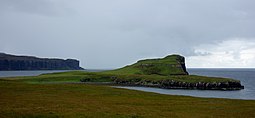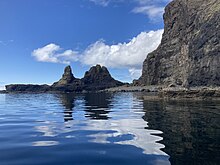| Scottish Gaelic name | Orasaigh |
|---|---|
| Old Norse name | Örfirirsey |
| Meaning of name | tidal island |
 View of Oronsay from Ullinish Point | |
| Location | |
| OS grid reference | NG316360 |
| Physical geography | |
| Island group | Skye |
| Area | 18 hectares (44 acres) |
| Highest elevation | 72 metres (236 ft) |
| Administration | |
| Council area | Highland |
| Country | Scotland |
| Sovereign state | United Kingdom |
| Demographics | |
| Population | 0 |
| Largest settlement | none |
| References | |


Oronsay (Scottish Gaelic: Orasaigh) is an uninhabited tidal island in Loch Bracadale on the west coast of Skye, Scotland.
It is c.1,000 metres (0.7miles) long by 220m wide running approximately north-east to south west.
At low tide (approx. below 4 metres) the island is connected to Ullinish Point on Skye via a narrow rocky causeway, some 200m long. The name Oronsay is believed to derive from the Old Norse for 'tidal island'.
The eastern part of the island, which faces Skye, is low-lying grass land, while the western part rises until it reaches several cliffs, up to 72 metres (240 ft) in height. Views from the westward side are to the Atlantic, Idrigill Point, Macleod's Maidens, with the much larger island of Wiay c.0.8 miles north-west, behind which the flat tops of Healabhal Bheag and Healabhal Mhòr (Macleod's Tables) dominate from the Duirinish Peninsula.
Behind Wiay some 2.7miles north-west is Harlosh Island (narrowly separated from Harlosh on Skye) and to the east of this, 1.7miles north-west (and directly north of Wiay) is Tarner Island.
Below the westernmost cliff of Oronsay sit several small sea stacks and the coast of the island contains several caves, however these are largely accessible except from the sea.
Oronsay is a well known hiking destination.
Images of the cliffs of Oronsay
-
 The most westerly point of the island, as viewed from the most southwesterly point, looking north
The most westerly point of the island, as viewed from the most southwesterly point, looking north
-
 The most southwesterly point of Oronsay, as viewed from the most westerly point, looking south
The most southwesterly point of Oronsay, as viewed from the most westerly point, looking south
-
 The cliffs along the northwestern side of the island, looking northeast
The cliffs along the northwestern side of the island, looking northeast
Footnotes
- Rick Livingstone’s Tables of the Islands of Scotland (pdf) Argyll Yacht Charters. Retrieved 12 Dec 2011.
- ^ National Records of Scotland (15 August 2013). "Appendix 2: Population and households on Scotland's Inhabited Islands" (PDF). Statistical Bulletin: 2011 Census: First Results on Population and Household Estimates for Scotland Release 1C (Part Two) (PDF) (Report). SG/2013/126. Retrieved 14 August 2020.
- Haswell-Smith, Hamish (2004). The Scottish Islands. Edinburgh: Canongate. ISBN 978-1-84195-454-7.
- Ordnance Survey: Landranger map sheet 23 North Skye (Dunvegan & Portree) (Map). Ordnance Survey. 2011. ISBN 9780319229897.
- "Northwest Skye - Oronsay". www.theskyeguide.com. Retrieved 14 October 2017.
- "Top 10 walks on Skye". theguardian.com. 23 May 2013. Retrieved 14 October 2017.
| Inhabited islands of the Hebrides | ||
|---|---|---|
| Inner Hebrides |  | |
| Outer Hebrides | ||
57°20′10″N 6°27′36″W / 57.33611°N 6.46000°W / 57.33611; -6.46000
This Highland location article is a stub. You can help Misplaced Pages by expanding it. |